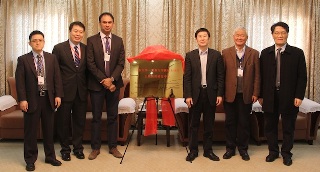Feb 4 2015
Scientists from Rice University and Shandong University, China, celebrated the opening of the Joint Center for Carbon Nanomaterials, a collaborative facility to study nanotechnology, on Feb. 1.
 At the opening ceremony, from left: Jun Lou of Rice University; Lijie Ci of Shandong University; Pulickel Ajayan of Rice; Shandong Vice President Han Shenghao; Professor Xie Sishen, academician of the Chinese Academy of Sciences; and Professor Zhao Guoquan, dean of the Shandong School of Materials Science and Engineering.
At the opening ceremony, from left: Jun Lou of Rice University; Lijie Ci of Shandong University; Pulickel Ajayan of Rice; Shandong Vice President Han Shenghao; Professor Xie Sishen, academician of the Chinese Academy of Sciences; and Professor Zhao Guoquan, dean of the Shandong School of Materials Science and Engineering.
Rice faculty members Pulickel Ajayan and Jun Lou, the chair and associate chair, respectively, of the university’s Department of Materials Science and NanoEngineering, took part in the ceremony along with Rice alumnus Lijie Ci, director of the new center and a professor of materials science and engineering at Shandong. The center’s dedication was part of the first International Workshop on Engineering and Applications of Nanocarbon, held Jan. 31-Feb. 2.
“We at Rice University are excited and honored to collaborate with Shandong University on this important endeavor,” Rice President David Leebron said in a message recorded for the ceremony. “The center represents and combines two very important initiatives for Rice: research excellence and applications in nanosciences and long-term partnerships with the best institutions worldwide.”
“A lot of people are working on carbon nanoscience on both campuses, and we expect they will be interested in taking part,” Ajayan said. “Nanotubes and graphene are essentially the building blocks for the center, but Lijie wants to build ecologically relevant, applied research that can be commercialized. That’s the long-term goal. All of the experience we have had in the area will be beneficial.”
Ajayan expects students from both universities will travel. “People from Rice will be engaged in some of the activities of this joint center, including advising students there. And we hope Shandong students will have the opportunity to come to Rice for a short time,” he said. “The center also contributes to Rice’s goal to build closer connections with China.”
Ajayan and Ci came to Rice together in 2007 from Rensselaer Polytechnic Institute; Ajayan was a faculty member and Ci was a postdoctoral researcher. At Rice, they introduced the darkest material ever measured at the time of its invention in 2008, an accomplishment that landed them in the Guinness Book of World Records.
They also collaborated on the first two-dimensional material to incorporate graphene and hexagonal boron nitride in a seamless lattice. Such 2-D materials have since become the focus of worldwide research for their potential as electronic components. And Ci, Lou and Ajayan worked together to study the nanoscale friction properties of carbon nanotubes.
Ajayan is Rice’s Benjamin M. and Mary Greenwood Anderson Professor in Engineering and a professor of materials science and nanoengineering and of chemistry. Lou is an associate professor of materials science and nanoengineering.